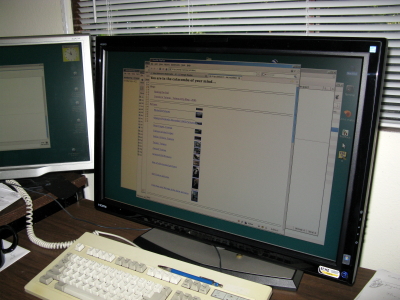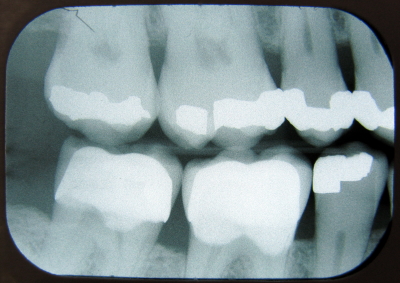Points for Windows: It’s a better package than Linux by 5 to 10 years. And has better software all around. Far cheaper in time. Supports more hardware. Better custom keyboard configuration. 4DOS. Semware TSE Windows is better than the current Linux beta.
Points for Linux: Ubuntu/Debian package manager system. Upgradable. Cloneable. Portable. Better file system. Cheaper in dollars. ssh server built in. Web server built in. Mail system built in. Text configuration and other attributes make it much better for hourly, daily, weekly, chug, chug, production jobs. Does not re-boot on its own.
The point may be moot. In due time either will be sitting in a closet.
And the answer is:
I figured it would be quicker to simply move the 3 hard drives from “spring” to “zoot”, the new machine. … … … And so the usual Linux saga began. It is now 7 hours later and many things are broken.
First, as expected, Linux could not handle the on-board ATI video. Two big monitors had barely readable pop-ups saying something on the order of “Failure”.
Net searches. Lots of time. Much confusion. In the end, it seemed like a better thing to do would be to toss in the extra Nvidia board. The extra was, I had always thought, a dupe of the one in spring. I’d made sure the machine’s spec’s allowed the board.
Well. Windows was not happy. Required a couple of scary reboots. And in the end, it had a bit different appearance and slower video. And audio was bogus. Sped up. And video had weird artifacts. Sped up animations. But both monitors came up in the same configuration they had with the motherboard ATI 3100.
So, back to Linux. I did several magical commands, but finally realized that my xorg.conf file was bogus from the ATI follies. Restoring it got the desktop up. Window movement was slow. Audio worked.
DNS stopped working during all this for no reason. I added the mvdomain dns server’s IP address to resolv.conf and would not be surprised if some program got rid of it. Somehow, networking decided to create yet another eth# interface – 4 this time. At least it had the correct, fixed IP address, though it’s hard to figure out how it got it.
Meanwhile, also during all this, Grub worked about once in 5 times. Error 18. Old error for old disks and old BIOS’s. During the video board follies, the ZT hard disk with Windows on it disappeared from BIOS’s list. Gone. A power cycle and some futzing brought it back. Probably the internal video needed to be explicitly disabled. Or something. Anyway, after I did that – and turned around and touched my nose with my left hand 3 times – Express Gate came back (it had died, too) and the disk came back.
All in all, this has been pretty much what it always is when you try to slightly alter a PC.
Oh. Did I mention that the machine’s four 3″ disk slots are really only three slots, unless you pull the CPU heatsink and fan. I started to do that before an imaginary helper slapped my face and I said, “Thanks. I needed that.” I simply bent some sheet metal.
So. 6 AM and back to breaking things. Gotta see if I can get the machine working with ATI. This Nvidia video is pretty bad. It takes most of one of the four cores just to paint System Monitor’s line. And Google Earth is black.
Long time later: All works with ATI on motherboard. Unfortunately, no particular method to make it work. Read some obscure web site that told how to downloaded and install ATI’s latest driver. Did several reboots and some things outside their “Control Panel”. Like most such software, their “Control Panel” is ragged. Must be run, sudo. Menu choice for doing so doesn’t work, of course. Must be run from command line by a secret name, “sudo amdcccle“. The chief outside program was aticonfig, a grabbag program. The chief outside task was to swap the monitor cables. Sure, taking 4 hours or so for video might seem excessive, but in fairness to Ubuntu, I didn’t get Win7 working well with the Nvidia board. I only tried for about 10 minutes, though. That’s enough time to spend on Windows troubles. It’s broken if it doesn’t work. With Linux, you’ve got to pour 12 hours in to something before you know it’s busted.
ZT update: The USB and card reader slots seem to be upside down. It took a second to find out why an SD card didn’t fit in the slot. And, there’s no excuse for the front panel USB being flipped. USB is troublesome enough with respect to orientation.
ZT update: When checking the specs on this box before buying it I completely forgot the little 400 gig music disk. Luckily, the ZT’s Asus motherboard had an IDE/ATA plug. The BIOS sure wanted to boot off the IDE drive, but all worked out in the end.
Porting:
One of Linux’s “killer apps” is that it can be moved to new hardware. “asuka”, A.K.A. “www.tranzoa.*” has roots back in the 90’s. This move of “spring” to a new box was not without troubles. But let’s put it in perspective. As a practical matter, moving to a new Windows means you start from scratch and reinstall everything you use. And the OS jump is generally through hyperspace. Moving a Linux box should be quick and easy. And has been for me several times.
Not this time.
Networking took an hour or so to get working reliably. In the end, I tossed the Ubuntu network manager entirely. That thing doesn’t work. And the horrid Gnome applet just makes it worse. Ubuntu would cut the distance it is behind Windows by half if networking, USB and video worked.
I am hoping USB2 works on the new box. I did use the built in SD card reader today – a good sign.
VMWare noticed that the host PC changed. I told it to “Move” the VMs, both XP and Karmic 32. Eventually, after VMWare zapped the VM around the screen like a jack rabbit, the Ubuntu Karmic 32 guest settled down to be OK. Full screen doesn’t work any more. The full screen “window” is put on the wrong monitor and there doesn’t seem to be a way to get it right. In full-screen, Windows XP stole the mouse focus and would not let go. Luckily it would not see the keyboard so ALT F4 saved the day. I’ll simply have to avoid going full screen. Sad. The Windows screen automatically scales to the window size, so desktop icons shuffle around making the VM pretty ugly. Now that Semware’s TSE almost runs under Linux there’s a lot less reason to kick over to Windows. Linux does need 4DOS or something like it. Gosh, all those Python shells and none are what I want. If it weren’t such a great idea for the ’80’s, I’d get to work on one, finally.
Anyway, VMWare’s “Player” keeps getting worse, version by version. Quite odd, that. Too bad kvm/qemu requires guru training and hours of net study to run.
The joke is on me: Turns out that the old “spring” box is probably just fine. No memory problems after all. Just bad software. My mistake. I bought a machine I did not need.
Signs of the times: When your new PC is a quad core, 3ghz, 8G, 1T box and it’s a “mistake,” you know that CPU and disk are officially plentiful.
So, bottom line: I stayed with Ubuntu. But I swear, if I get sucked in to many more Linux time sinks, that Win7 Terabyte drive that Ubuntu doesn’t see is gonna look real pretty to me.



 Click to see the pictures
Click to see the pictures